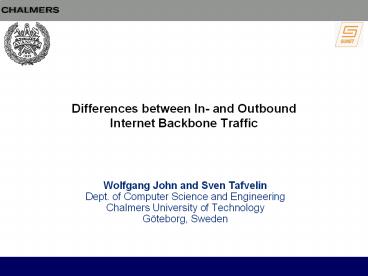Differences between In- and Outbound Internet Backbone Traffic PowerPoint PPT Presentation
Title: Differences between In- and Outbound Internet Backbone Traffic
1
Differences between In- and Outbound Internet
Backbone Traffic
- Wolfgang John and Sven TafvelinDept. of Computer
Science and EngineeringChalmers University of
TechnologyGöteborg, Sweden
2
Overview
- Introduction
- Highlights of directional differences on
- IP level
- TCP level
- UDP level
- Summary of results
- Conclusions
3
Introduction Motivation
- Why measuring on Internet links?
- to understand the nature of Internet traffic
- quantify deployment of protocol features
- Interesting for
- Network engineers and protocol developers
- Network modeling and simulation community
- Network security and intrusion detection
4
Introduction Related work
- Directional differences on backbone traffic
- Evident on simple packet header analysis
- Correlation of packets might reveal reasons
- Related work
- Mainly unidirectional flow data (NetFlow)
- Either low or very high aggregation level
- Marginal discussion on directional differences
5
Introduction Our contribution
- Complete view on different levels
- Contemporary data
- Packet level analysis
- Bi-directional TCP connections
- Specific measurement location
- Medium aggregation level
- Suitable for highlighting directional differences
6
Introduction Measurement location
Internet
- 2x 10 Gbit/s (OC-192)
- 2x DAG6.2SE Cards
- tightly synchronized
- capturing headers
Sthlm
Stud-Net
Regional ISPs
Gbg
Chalmers Univ.
Göteborgs Univ.
7
Introduction General traffic characteristics
- Data from 20 days in April 2006
- 146 traces, 10.7 billion frames, 7.5 TB
- 99.99 IPv4 data
- 93 TCP packets
- 97 TCP data
- Data and packet counts equal on inbound and
outbound links!
8
Highlights IP level
- Distinct IP addresses seen (in Millions)
9
Highlights IP level
- Distinct IP addresses seen (in Millions)
- Surprisingly large numbers
- Inbound destinations gtgt outbound sources
- Outside hosts primarily due to UDP
10
Highlights TCP level
- Connection attempt breakdown (Millions)
11
Highlights TCP level
- Connection attempt breakdown (Millions)
- Inbound connections mainly scans!
12
Highlights TCP level (2)
- TCP termination behavior (Millions)
13
Highlights TCP level (2)
- TCP termination behavior (Millions)
- Only 67 close properly (2xFIN)
- Inbound 20 of conn. closed by FIN and RST!
14
Highlights TCP level (3)
- Statistical properties of established TCP
connections - Lifetime, data volume, packet count
- Inbound connections more likely to
- show lifetimes between 1 and 5 seconds
- be long lasting (gt10 minutes)
- carry more data and more packets
- show higher asymmetry (client-server pattern)
15
TCP level P2P traffic
- Quantification according to port-numbers
- Missing payload
- ? underestimated by factor 2-3 ,
- 13 of data in outbound connections
- 25 of data in inbound connections
S. Sen et al, Accurate, Scalable
in-network identification of P2P traffic across
large networks, IMW 2002 T. Karagiannis et
al, Transport layer identification of P2P
Traffic, ACM SIGCOMM 2004
16
Highlights UDP level
- 68 million UDP flows
- 51 million carry less than 3 packets!
- DNS 5 NTP 1.7
- Incoming scanning gt 8
- P2P overlay traffic gt 20
- Signaling Traffic
- Distributed Hash Table (DHT) like Kademlia
- Update routing tables in decentralized way
- Periodic ping queries and replies
- P2P overlay networks span entire globe
- High fluctuation in peering partners ? lots of
IPs
17
Summary of results
- Besides equal counts and volumes on both links,
directional differences were found in - IP packet sizes
- IP fragmentation
- Number of TCP connections
- TCP connection establishment termination
- TCP option usage
- TCP connection properties
- UDP scanning traffic
18
Conclusion
- High level analysis does not necessarily show
differences ? detailed analysis does! - 2 main reasons for directional differences
- Malicious traffic
- the Internet is unfriendly
- P2P
- Göteborg is a P2P source
- P2P is changing traffic characteristicse.g.
packet sizes, TCP termination, TCP option usage
19
Thank you very much for you attention!
- Questions?
20
BACKUP
- BACKUP SLIDES
21
Common P2P port numbers
22
TCP level (4)
- TCP options (in )
23
TCP level (4)
- TCP options (in )
24
IP level (2)
- Packet size distribution on the 2 links
25
IP level (2)
- Packet size distribution on the 2 links
26
IP level (3)
- IP fragmentation on the 2 links
27
Malicous traffic / P2P traffic
- Connection properties
lifetime in sec

